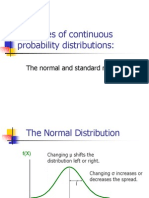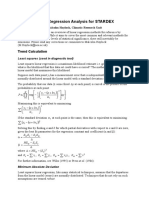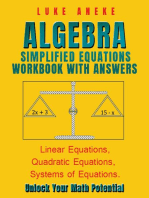Range Stat
Range Stat
Uploaded by
Dilrukshi FernandoCopyright:
Available Formats
Range Stat
Range Stat
Uploaded by
Dilrukshi FernandoOriginal Description:
Copyright
Available Formats
Share this document
Did you find this document useful?
Is this content inappropriate?
Copyright:
Available Formats
Range Stat
Range Stat
Uploaded by
Dilrukshi FernandoCopyright:
Available Formats
Range
The range is the simplest measure of variation to find. It is simply the highest
value minus the lowest value.
RANGE = MAXIMUM - MINIMUM
Since the range only uses the largest and smallest values, it is greatly
affected by extreme values, that is - it is not resistant to change.
Variance
"Average Deviation"
The range only involves the smallest and largest numbers, and it would be
desirable to have a statistic which involved all of the data values.
The first attempt one might make at this is something they might call the
average deviation from the mean and define it as:
ave dev = sum ( x - mu ) / N
The problem is that this summation is always zero. So, the average deviation
will always be zero. That is why the average deviation is never used.
Population Variance
So, to keep it from being zero, the deviation from the mean is squared and
called the "squared deviation from the mean". This "average squared
deviation from the mean" is called the variance.
sigma^2 = sum ( x - mu )^2 / N
Unbiased Estimate of the Population Variance
One would expect the sample variance to simply be the population variance
with the population mean replaced by the sample mean. However, one of the
major uses of statistics is to estimate the corresponding parameter. This
formula has the problem that the estimated value isn't the same as the
parameter. To counteract this, the sum of the squares of the deviations is
divided by one less than the sample size.
s^2 = sum ( x - x bar )^2 / ( n - 1 )
Standard Deviation
There is a problem with variances. Recall that the deviations were squared.
That means that the units were also squared. To get the units back the same
as the original data values, the square root must be taken.
sigma = sqrt ( sigma^2 )
s = sqrt ( s^2 )
The sample standard deviation is not the unbiased estimator for the
population standard deviation.
The calculator does not have a variance key on it. It does have a standard
deviation key. You will have to square the standard deviation to find the
variance.
Sum of Squares (shortcuts)
The sum of the squares of the deviations from the means is given a shortcut
notation and several alternative formulas.
A little algebraic simplification returns: sum of x^2 - ( sum of x )^2 / n
What's wrong with the first formula, you ask? Consider the following example
- the last row are the totals for the columns
Total the data values: 23
Divide by the number of values to get the mean: 23/5 = 4.6
Subtract the mean from each value to get the numbers in the second column.
Square each number in the second column to get the values in the third
column.
Total the numbers in the third column: 5.2
Divide this total by one less than the sample size to get the variance: 5.2 / 4
= 1.3
x
( x - x bar ) ( x - x bar )^2
4 - 4.6 = -0.6
5 - 4.6 = 0.4 ( 0.4 ) ^2 = 0.16
3 - 4.6 = -1.6
6 - 4.6 = 1.4 ( 1.4 )^2 = 1.96
5 - 4.6 = 0.4 ( 0.4 )^2 = 0.16
( - 0.6 )^2 = 0.36
( - 1.6 )^2 = 2.56
23
0.00 (Always)
5.2
Not too bad, you think. But this can get pretty bad if the sample mean
doesn't happen to be an "nice" rational number. Think about having a mean
of 19/7 = 2.714285714285... Those subtractions get nasty, and when you
square them, they're really bad. Another problem with the first formula is that
it requires you to know the mean ahead of time. For a calculator, this would
mean that you have to save all of the numbers that were entered. The TI-82
does this, but most scientific calculators don't.
Now, let's consider the shortcut formula. The only things that you need to
find are the sum of the values and the sum of the values squared. There is no
subtraction and no decimals or fractions until the end. The last row contains
the sums of the columns, just like before.
Record each number in the first column and the square of each number in the
second column.
Total the first column: 23
Total the second column: 111
Compute the sum of squares: 111 - 23*23/5 = 111 - 105.8 = 5.2
Divide the sum of squares by one less than the sample size to get the
variance = 5.2 / 4 = 1.3
x
x^2
16
25
36
25
23
111
Chebyshev's Theorem
The proportion of the values that fall within k standard deviations of the
mean will be at least 1 - 1 / k^2, where k is an number greater than 1.
"Within k standard deviations" interprets as the interval: x bar - k * s to x bar
+ k * s.
Chebyshev's Theorem is true for any sample set, not matter what the
distribution.
Empirical Rule
The empirical rule is only valid for bell-shaped (normal) distributions. The
following statements are true.
Approximately 68% of the data values fall within one standard deviation of
the mean.
Approximately 95% of the data values fall within two standard deviations of
the mean.
Approximately 99.7% of the data values fall within three standard deviations
of the mean.
The empirical rule will be revisited later in the chapter on normal
probabilities.
Using the TI-82 to find these values
You may use the TI-82 to find the measures of central tendency and the
measures of variation using the list handling capabilities of the calculator.
You might also like
- R Lab - Probability DistributionsDocument10 pagesR Lab - Probability DistributionsPranay PandeyNo ratings yet
- Algorithms For Calculating VarianceDocument11 pagesAlgorithms For Calculating Varianceisabella343No ratings yet
- Sec 1 Math Revision NotesDocument95 pagesSec 1 Math Revision NotesAlvin AiauNo ratings yet
- SymmetryDocument60 pagesSymmetryDeepak TholiaNo ratings yet
- UR5 Inverse KinematicsDocument8 pagesUR5 Inverse KinematicsLuis Gerardo CarvajalNo ratings yet
- KY.UNIT 3Document20 pagesKY.UNIT 3khushiyadav88400No ratings yet
- Discriptive StatisticsDocument50 pagesDiscriptive StatisticsSwathi JanardhanNo ratings yet
- Measures of VariabilityADocument19 pagesMeasures of VariabilityAcaileyandrea19No ratings yet
- MMW Module 4.2 - Statistics - Measures of Variation, Normal Distribution & Simple RegressionDocument9 pagesMMW Module 4.2 - Statistics - Measures of Variation, Normal Distribution & Simple RegressionErille Julianne (Rielianne)No ratings yet
- Numericals ReviewerDocument17 pagesNumericals ReviewerJeremy MacalaladNo ratings yet
- Virtual University of Pakistan: Lecture No. 11Document39 pagesVirtual University of Pakistan: Lecture No. 11Atif KhanNo ratings yet
- Variancestandarddeviation 170416111818Document22 pagesVariancestandarddeviation 170416111818MAYNo ratings yet
- 5 Normal DistributionDocument34 pages5 Normal DistributionLa JeNo ratings yet
- Hacettepe University Department of Environmental EngineeringDocument37 pagesHacettepe University Department of Environmental EngineeringDilan AğkoçNo ratings yet
- Scientific Notation and Significant FiguresDocument18 pagesScientific Notation and Significant FiguresLawrence AnDrew FrondaNo ratings yet
- Lecture 3Document42 pagesLecture 3S.WaqquasNo ratings yet
- 4 Normal DistributionDocument40 pages4 Normal Distributionyaamer54No ratings yet
- Basic Probability Reference Sheet: February 27, 2001Document8 pagesBasic Probability Reference Sheet: February 27, 2001Ibrahim TakounaNo ratings yet
- Normal Distribution-7Document5 pagesNormal Distribution-7Shobha Kumari ChoudharyNo ratings yet
- Error and Uncertainty: General Statistical PrinciplesDocument8 pagesError and Uncertainty: General Statistical Principlesdéborah_rosalesNo ratings yet
- ch1 PDFDocument15 pagesch1 PDFJaskirat SinghNo ratings yet
- Session 4-5 Reference: SFM Ch.5Document24 pagesSession 4-5 Reference: SFM Ch.5Vikas YadavNo ratings yet
- Stat 3Document42 pagesStat 3Al Arafat RummanNo ratings yet
- STAT110 Spring 2017 2018part3Document33 pagesSTAT110 Spring 2017 2018part3Ahmmad W. MahmoodNo ratings yet
- Descriptive Descriptive Analysis and Histograms 1.1 Recode 1.2 Select Cases & Split File 2. ReliabilityDocument6 pagesDescriptive Descriptive Analysis and Histograms 1.1 Recode 1.2 Select Cases & Split File 2. Reliabilitydmihalina2988100% (1)
- 06-14-PP CHAPTER 06 Continuous ProbabilityDocument81 pages06-14-PP CHAPTER 06 Continuous ProbabilityNawarajPokhrelNo ratings yet
- ECON1203 PASS Week 3Document4 pagesECON1203 PASS Week 3mothermonkNo ratings yet
- Week-6-Quadratic-Inequalities-newDocument24 pagesWeek-6-Quadratic-Inequalities-newaudreynramosNo ratings yet
- DOM105 Session 3Document17 pagesDOM105 Session 3Tanish GandhiNo ratings yet
- Case StudyDocument9 pagesCase StudyAyoade Tobi DanielNo ratings yet
- Continuous Probability Distribution PDFDocument47 pagesContinuous Probability Distribution PDFDipika PandaNo ratings yet
- Measures of Dispersion - 1Document44 pagesMeasures of Dispersion - 1muhardi jayaNo ratings yet
- Chapter 4Document8 pagesChapter 4NJeric Ligeralde AresNo ratings yet
- IGNOU AssignmentDocument9 pagesIGNOU AssignmentAbhilasha Shukla0% (1)
- Process Control Concepts Through Statistics: N X N X X X X XDocument14 pagesProcess Control Concepts Through Statistics: N X N X X X X XVeeresha YrNo ratings yet
- InequalitiesDocument6 pagesInequalitiesDev SapphireNo ratings yet
- 1305 Notes CH02Document26 pages1305 Notes CH02Zarlish KhanNo ratings yet
- Numerical AnalysisDocument13 pagesNumerical AnalysisJaspreetBrarNo ratings yet
- Lecture4 - Linear Algebraic Equations - 11march2024 - NK - v1Document53 pagesLecture4 - Linear Algebraic Equations - 11march2024 - NK - v1yamanfNo ratings yet
- Num MathDocument87 pagesNum MathshubhamNo ratings yet
- الفصل الثاني الاحصاءDocument27 pagesالفصل الثاني الاحصاءbifusk481No ratings yet
- Math LinksDocument16 pagesMath LinksMarlo Lao BernasolNo ratings yet
- ClassLectures Numerical MethodsDocument84 pagesClassLectures Numerical MethodsFaisal Baig50% (2)
- KWT 4.ukuran Keragaman Data 2013Document29 pagesKWT 4.ukuran Keragaman Data 2013AndiNo ratings yet
- Measures of Dispersion TendencyDocument7 pagesMeasures of Dispersion Tendencyashraf helmyNo ratings yet
- The Central Limit TheoremDocument8 pagesThe Central Limit TheoremChriselle RNo ratings yet
- HW 2Document3 pagesHW 2amanat.rahmanNo ratings yet
- Examples of Continuous Probability Distributions:: The Normal and Standard NormalDocument57 pagesExamples of Continuous Probability Distributions:: The Normal and Standard NormalPawan JajuNo ratings yet
- AP Stats Study Guide 1 1 1Document21 pagesAP Stats Study Guide 1 1 1LLLLNo ratings yet
- Tugas Kuliah Statistika SESI 4Document4 pagesTugas Kuliah Statistika SESI 4CEOAmsyaNo ratings yet
- 04 NormalDistributionDocument43 pages04 NormalDistributionShane Olen GonzalesNo ratings yet
- Chapter2-New (Compatibility Mode)Document52 pagesChapter2-New (Compatibility Mode)Hafiz SuhaimiNo ratings yet
- Presentation 3Document26 pagesPresentation 3Levi PogiNo ratings yet
- Q3 Mathematics Peer Tutoring: Students' Advisory BoardDocument93 pagesQ3 Mathematics Peer Tutoring: Students' Advisory BoardKiminiNo ratings yet
- The Normal Distribution 5: Elementary StatisticsDocument34 pagesThe Normal Distribution 5: Elementary StatisticsNoor HafizahNo ratings yet
- Evaluation of Analytical DataDocument58 pagesEvaluation of Analytical DataJoyce Mariele RomeroNo ratings yet
- ProbalityDocument8 pagesProbalitySumit SharmaNo ratings yet
- Group 2Document65 pagesGroup 2Fazal McphersonNo ratings yet
- Normal Distribn TheoryDocument16 pagesNormal Distribn TheoryGuru Ballur0% (1)
- Topic 2 Part III PDFDocument30 pagesTopic 2 Part III PDFChris MastersNo ratings yet
- Linear Regression Analysis For STARDEX: Trend CalculationDocument6 pagesLinear Regression Analysis For STARDEX: Trend CalculationSrinivasu UpparapalliNo ratings yet
- ALGEBRA SIMPLIFIED EQUATIONS WORKBOOK WITH ANSWERS: Linear Equations, Quadratic Equations, Systems of EquationsFrom EverandALGEBRA SIMPLIFIED EQUATIONS WORKBOOK WITH ANSWERS: Linear Equations, Quadratic Equations, Systems of EquationsNo ratings yet
- Integers CombinedDocument7 pagesIntegers CombinedNupur KaulNo ratings yet
- Ghulam Muhammad: Address: Lecturer - 05/2014 To 5/2019 Teaching Assistant, IBA KarachiDocument1 pageGhulam Muhammad: Address: Lecturer - 05/2014 To 5/2019 Teaching Assistant, IBA KarachiGhulam Muhammad BismilNo ratings yet
- A Nice Combinatorial Problem PDFDocument2 pagesA Nice Combinatorial Problem PDFDoli PaikNo ratings yet
- Algebra For College Entrance ExaminationsDocument2 pagesAlgebra For College Entrance ExaminationsLin Xian XingNo ratings yet
- Matrices Olevel CalaDocument5 pagesMatrices Olevel CalaMoses AjiwekaNo ratings yet
- Evaluation of The Rotation Matrices in The Basis of Real Spherical HarmonicsDocument9 pagesEvaluation of The Rotation Matrices in The Basis of Real Spherical HarmonicsZuxin JinNo ratings yet
- A Finite Element Study of The Geometric Centrifrugal Stiffening EffectDocument44 pagesA Finite Element Study of The Geometric Centrifrugal Stiffening EffectGerry RyanNo ratings yet
- Measure of Central TendencyDocument113 pagesMeasure of Central TendencyRajdeep DasNo ratings yet
- Matrices DPP 02 (Of Lec 04) Prayas JEE 2.0 2025Document3 pagesMatrices DPP 02 (Of Lec 04) Prayas JEE 2.0 2025subhashsajankar70No ratings yet
- Pram Algorithms: Parallel and Distributed Algorithms BY Debdeep Mukhopadhyay AND Abhishek SomaniDocument17 pagesPram Algorithms: Parallel and Distributed Algorithms BY Debdeep Mukhopadhyay AND Abhishek SomaniPariti ShastriNo ratings yet
- Inferencia Ejercicios EstadisticaDocument7 pagesInferencia Ejercicios EstadisticafaniNo ratings yet
- Equivalent Circuits of Electric MachineryDocument1 pageEquivalent Circuits of Electric Machinerytonimur1967No ratings yet
- FunDocument165 pagesFunStudy EasyNo ratings yet
- MathsDocument4 pagesMathsJones calvinNo ratings yet
- Squeezed Coherent States For A Free Particle With Time-Varying MassDocument14 pagesSqueezed Coherent States For A Free Particle With Time-Varying MassRoberto QuadrosNo ratings yet
- Daa Assignment 3Document16 pagesDaa Assignment 3Logan XmenNo ratings yet
- ABET Course Syllabus - Spring Semester 2024/2025 CS11102 Introduction To Computer ScienceDocument4 pagesABET Course Syllabus - Spring Semester 2024/2025 CS11102 Introduction To Computer Sciencesaraalqaisi2005No ratings yet
- 2023 EM04 Geometrical Properties of Circles NotesDocument27 pages2023 EM04 Geometrical Properties of Circles NotesPRIYA .VNo ratings yet
- Measures of Central Tendency and VariabilityDocument38 pagesMeasures of Central Tendency and Variabilityapi-619738021No ratings yet
- African American Wax Museum Final VersionDocument59 pagesAfrican American Wax Museum Final VersionElaine Faulk-DonnellyNo ratings yet
- TISCO Apprentice Exam PatternDocument3 pagesTISCO Apprentice Exam Patternkrishnagupta24.120No ratings yet
- Skin FactorDocument12 pagesSkin FactorHUGO BARRIOS DRULLISNo ratings yet
- Ma 123 Homework AnswersDocument4 pagesMa 123 Homework Answersafnofjmzeldfie100% (1)
- Level 1 FractionsDocument12 pagesLevel 1 Fractionsmdot95No ratings yet
- Chapter 5 (What-If Analysis For Linear Programming)Document26 pagesChapter 5 (What-If Analysis For Linear Programming)ripeNo ratings yet
- Mathematics and Astrology: DescriptionDocument2 pagesMathematics and Astrology: DescriptionKABILOGESNo ratings yet
- The Order of Numbers and The Goldbach ConjectureDocument5 pagesThe Order of Numbers and The Goldbach ConjectureAnonymous lVQ83F8mCNo ratings yet

























































































